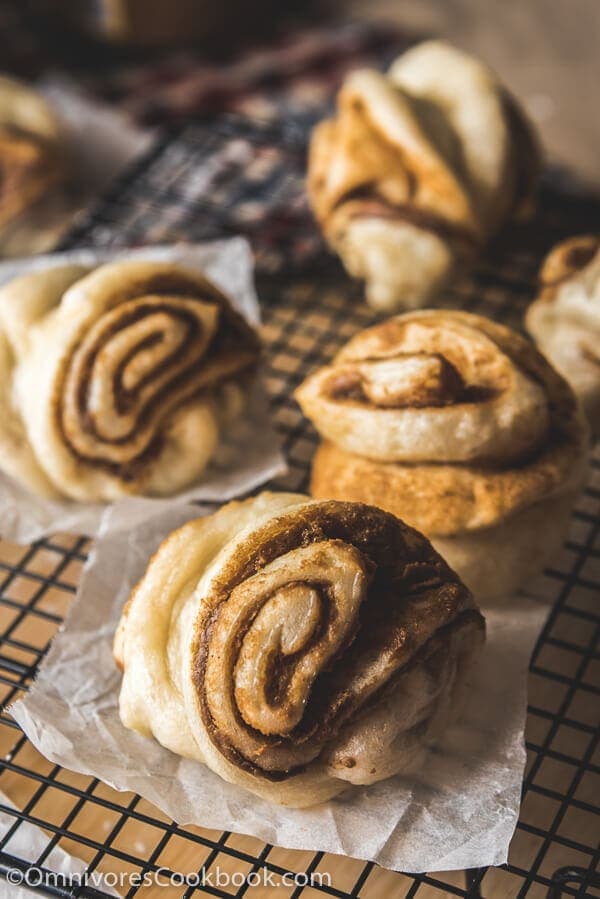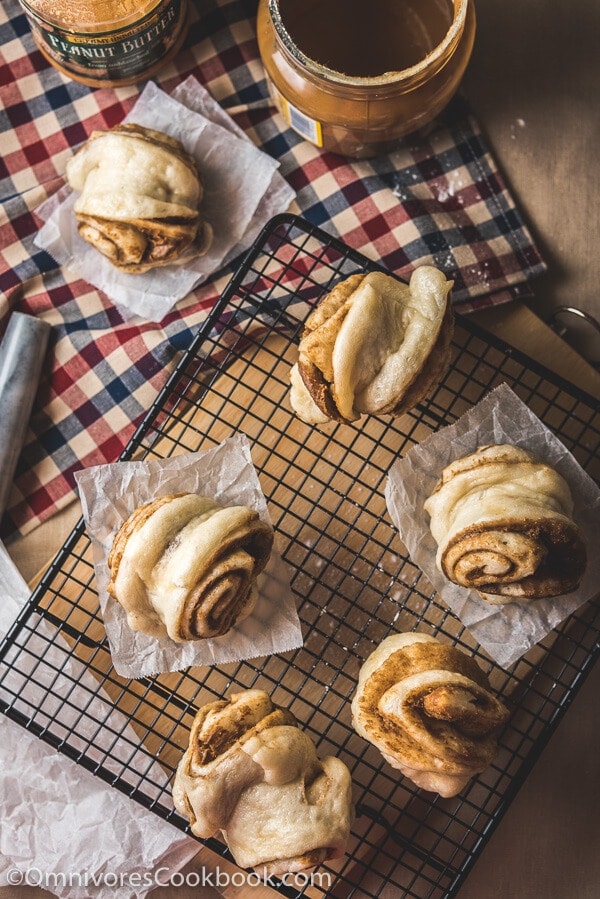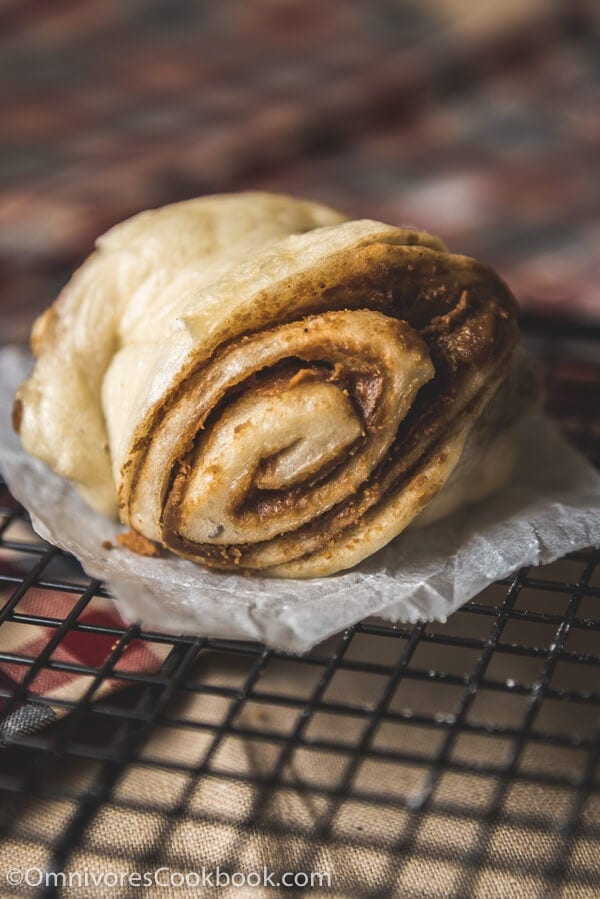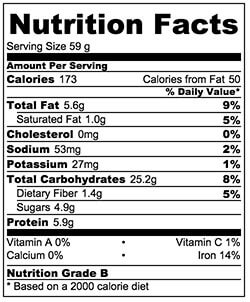
These nutty steamed buns are a perfect side for dinner. The buns are stuffed with sesame paste and sugar, then steamed until fluffy and light. They’re so comforting and great tasting that you don’t even need to serve other dishes to create a nice meal.
Have you ever heard of Hua Juan (花卷)? Hua Juan literally means flower roll, and refers to a steamed bun that has a very simple filling. The filling can be sweet or savory. The idea of the bun is quite similar to that of the cinnamon roll, with only one further step required to shape the bun. After you cut the rolled-up dough to reveal a swirl pattern, you twist the dough to shape it like a flower.
Steamed buns are daily staple in northern China. Some people prefer to serve them as a side for their meals instead of rice because they taste great by themselves. For a quick and easy dinner, my mom will serve these buns with a bowl of very simple congee or soup (millet porridge or hot and sour soup for example), with a vegetable dish.
These sweet steamed buns use toasted sesame paste (a Chinese-style tahini) and sugar to make a sweet and nutty filling. The sesame paste (芝麻酱, zhi ma jiang) is quite similar to natural peanut butter, only nuttier and stronger in flavor. I have included peanut butter as an alternative in the recipe below, but I highly recommend you to give Chinese tahini a try. It is an ingredient with a truly Chinese flavor.

Thick sesame paste with sugar was one of my favorite snacks during my childhood. We didn’t have a lot of fancy desserts 20 years ago. There were only 2 flavors of popsicle to choose from. We could get cookies once in a while, but I don’t really have any memories of them before middle school. The truth is, dessert has never been a major part of traditional Chinese cuisine.
The sesame paste with sugar one of the few sweets I had growing up. And it brings back happy memories of the good old days. We usually enjoy it in one of two ways. One is to spread it on a plain steamed yeast roll, just like you’d eat peanut butter on a piece of bread. The other way is to cook these nutty steamed buns with the paste as filling. My favorite thing to do during cooking was to use my finger to clean the bowl that contained the sugar-infused sesame paste, and eat the last few bits of it. It’s so good!

These steamed buns are really easy to make. As long as you knead the dough with enough strength and let the dough rest long enough, you will get very fluffy buns. The only tricky thing is shaping the bun. The big dilemma is: if you add too much filling, the buns will become a bit messy when you shape them, but the more filling you add, the tastier the buns will be. I guess I always stuff too much filling, myself. If you find the filling about to spill before you twist and shape the flower, you can simply steam the the buns without the final shaping. They will be equally delicious.

Do you like my recipes? Sign up for Omnivore’s Cookbook’s weekly newsletter to get the latest updates delivered to your inbox and a free e-cookbook!
Chinese Cooking Made Easy
Are you new to this website? This free email series is a great place to start. I’ll walk you through a few of my most popular recipes and show you how and why they work. You’ll quickly start to cook better Chinese food in your own kitchen.

Nutty Steamed Buns (芝麻酱花卷, Sweet Hua Juan)
Ingredients
- 300 grams 10 ounces all-purpose flour (*see conversion to cups)
- 1 teaspoon instant dry yeast
- 225 milliliters slightly less than 1 cup water (room temperature)
- 1/2 cup Chinese sesame paste or natural peanut butter
- 1/4 cup sugar
Instructions
- Add flour and instant dry yeast to a big bowl. Mix well with a spatula.
- Slowly add water and mix with a spatula, until the water is fully absorbed and there is no dry flour on the bottom of the bowl (*see footnote 1). The dough should feel very soft and sticky.
- Dust both hands with flour. Start kneading with hand. The dough might stick to your hand easily. Add plenty of flour and continue to knead, until dough forms.
- Dust a thin layer of flour on a working surface (or a large cutting board). Transfer the dough to the working surface and keep kneading. If the dough starts to feel sticky, add more flour. Knead until the dough become consistent in texture, about 10 minutes.
- Transfer the dough to a big bowl. Cover with a wet clean kitchen towel and place a lid on the bowl. Let rest for 30 minutes at room temperature.
- Dust the working surface and both hands again. Transfer the dough to the working surface. Knead the dough for about 10 minutes, until the surface becomes smooth.
- Divide the dough in half. Knead each piece of dough a few times to shape a ball. Cover the dough with a damp and clean kitchen towel.
- Let rest for 1 hour, until the texture becomes fluffy and tender and the size nearly doubles.
- Stir the sesame paste (or peanut butter) until the texture becomes consistent (*see footnote 2). Add the sesame paste and sugar to a bowl. Mix well and set aside.
- Dust the working surface and the dough with flour. Work on the dough pieces one by one.
- Use a rolling pin to roll the dough into a large rectangular sheet, about the thickness of two dollar coins.
- Spread half of the sesame paste (or peanut butter paste) evenly on the dough sheet to form a thin layer, leaving about 2cm (0.8 inches) away from the edge. If the dough you roll is a bit thicker, you may not able to use all the sesame paste. (*see footnote 3)
- Roll the sheet from the short side carefully, to form a roll.
- Carefully divide the roll into six even parts with a sharp knife without squeezing out the filling.
- {Option 1} To shape the flowers, work on the buns one by one. Take one bun with both hands so that the swirl side faces down. Slightly press the middle of the bun (non-swirl side) and pull the swirl-pattern parts of the bun towards you on both sides. Fold the bun so that the two swirl sides both face up. Twist the two ends in opposite directions, then pinch both ends together, and lightly press the dough together. Place the pinched side down on the working surface.
- {Option 2} If you don’t feel like shaping the buns, or are simply finding it difficult to twist them, having put too much filling into the dough, you can skip last step and steam the buns directly.
- If you have a very large steamer rack, you can work on the other piece of dough now and steam the two batches together. Otherwise, start steaming the first batch now, and work on the next batch at the same time.
- Add water to a steamer. Place a wet, clean dish towel (*see footnote 4) on the steaming rack. The water should be 2cm (0.8 inch) below the steaming rack. Carefully transfer the buns onto the rack, with at least 2 cm (0.8 inch) between them. Let the buns rest on the rack for 10 minutes.
- Heat the steamer over high heat until the water begins to boil. Turn to medium or medium high heat while keeping the water boiling. Steam the buns for 12 minutes, until the buns are cooked through.
- Be careful of the steam when you remove the cover of the steamer. Let the buns cool for a minute before transferring them to a plate.
- Serve warm.
Store and reheat
- Store leftover buns in an airtight container in the fridge up to 3 days, or in the freezer up to a month.
- To reheat the buns, you can either use a steamer or the microwave. The former generates fluffy and soft buns, just like freshly cooked ones, but takes longer time.
- To reheat with a steamer - Just heat the buns by following the steps above, the same way you cooked the buns initially, but instead of putting the buns on the kitchen towel, you can place them on a plate.
- To reheat in microwave - Add the buns and a teaspoon of water into a bowl. Loosely cover the bowl with a lid. Microwave until the buns turns warm and soft. Please note, the buns might turn a bit chewy if you use this method.
Notes
2. The Chinese sesame paste is usually thick at the bottom of the jar. Try to scoop the thicker part to use in this recipe. If you use the thin part, the bun may not hold its shape well.
3. Spread just a thin layer of sesame paste on the dough, otherwise the paste will spill after you cut the dough.
4. You can use steamer liner as alternative. Or use a piece of parchment, cut into the shape of the steaming rack, and cut a few small holes on the sheet.

Did you make this recipe?
I’d love to hear how it turned out for you! Please take a moment to leave a 5-star rating ⭐️ and share your thoughts in the comments further down the page. It really helps others discover the recipe too.
The nutrition facts are calculated based on 1 of the 12 buns generated by this recipe.


Anna
Hi Maggie,
isn’t there the possibility to roast tahini? I always got this in my fridge, so I wouln’t need to buy something extra.
Anna
Maggie
Hi Anna, I think you can try to use tahini with a spoon of toasted sesame oil to replace the toasted sesame paste. I don’t think there’s a way to roast tahini.
bread&bao_girl
Great recipe, worked out perfectly! My parents would be so proud. I would only note that it’s good to spread the paste out to the edge for the long edges because otherwise the two 1/6 ends of the logs will have very little paste in them. Also, mixing the sugar in the paste made it a little granier and harder to spread. What I’ve done in the past is to sprinkle sugar on top, and I might try that again next time. But the dough was yummy , even without proofing the yeast first.
Maggie
So happy to hear you made this recipe and enjoy the dish! Spreading the sugar on the paste sounds like a great idea. Thanks so much for sharing and I’d love to try it out next time 🙂
Prash @ YummilyYours
You know, I saw the whole process and then bam! You steamed them and not bake! I can only imagine the marvelous flavors Maggie! Delish 🙂
Madiha Nawaz
I really enjoyed reading and learning about these buns! Since I love cinnamon rolls and have literally grown up eat tahini therefore, I’m certain that I’d love these buns too. The most interesting part that really got intrigued to me is that they are steamed and for that reason, I shall be trying out this recipe soon 🙂
Thanks for sharing!
Madiha Nawaz
Really got me intrigued*
Kathleen | HapaNomNom
Oh my, Maggie! I have a bit of an obsession with steamed buns, and sesame paste is like pure gold! You have such a wonderful way of explaining the process of making all of your wonderful dishes – pinning to make for sure!
Amanda@ChewTown
Such gorgeous looking buns. I love how they are made with the little twist of the dough at the end!
Alice @ Hip Foodie Mom
Maggie, these buns are gorgeous!
Peter @ Feed Your Soul Too
Maggie, these look totally awesome.
Meggan | Culinary Hill
I really enjoyed your story about growing up, Maggie! Reading your blog is a lovely window into life in another country and I always learn so much. Thank you for sharing your memories and your recipe. 🙂
Levan @ MyWifeMakes.com
Another AWESOME recipe Maggie! Love the detailed step-by-step instructions, and of course, LOVE the steamed buns! Thanks for sharing!!! FIVE STARS!
Meri Rasoi – By saumya Mishra
Looks so simple to make, love the quick and easy recipes 🙂
Michelle @ Vitamin Sunshine
Those are beautiful Maggie– I am sure you’ve seen China change a lot over the years. I’ve seen Malaysia change a ton over the past 5 years — globalization! My husband traveling in China when he was younger, and he talks about how limited the food options were. How he would go days just eating rice when he was outside the cities. Crazy how much the food culture has been influenced there.
shobelyn
This almost look like a cinnamon roll and these buns looks like flower 🙂
Insanely Roy
First of all, I love the pictures. great clicks.
and those flowers buns… #Foodporn
I make a makeshift steamer with a colander and it works great. i made momos and idlis in them 🙂
so for me steamed buns is good news.
i will try these sure. 🙂
bookmarkng this right away 🙂
http://pieceofcerebrum.wordpress.com
Kelly – Life Made Sweeter
These look absolutely mouthwatering, Maggie! Seamed buns were one of my favorites when I was growing up! I love that you filled them with a sweet sesame paste filling! They sound delicious!
Nancy | Plus Ate Six
Seriously – every single recipe you post I want to eat.
Robyn @ Simply Fresh Dinners
Oh my goodness! I’m craving something like this these days. I love my fresh fruit and veggies but sometimes you just need that something extra. These are really beautiful, Maggie! Sharing all over 🙂
Bam’s Kitchen
Glorious buns!!! I only like delicately sweet desserts and this is beautiful. I guess I could use black sesame paste too, right? I have that in my pantry now… I love your process and can’t wait to see your video on this one to really understand the process of making the flower…I hope that even after you move you continue to make many Chinese dishes from your childhood… Take care
Helen @ Scrummy Lane
My goodness, these look SO amazing, Maggie! I’m in love with them even without having tried anything like them before because I know I LOVE tahini and I love cinnamon rolls so yes … you definitely sold them to me!
I was interested to read that these are served with savoury dishes! Is the sweet-savour combo popular in China?
Kevin | keviniscooking
In the numerous Dim Sum houses we go to and have been, as well as different Chinese restaurants, dessert has never been a big hit or even available. BUT, these sound and look superb! Love the sweetened Chinese tahini here and steamed buns? Sign me up!